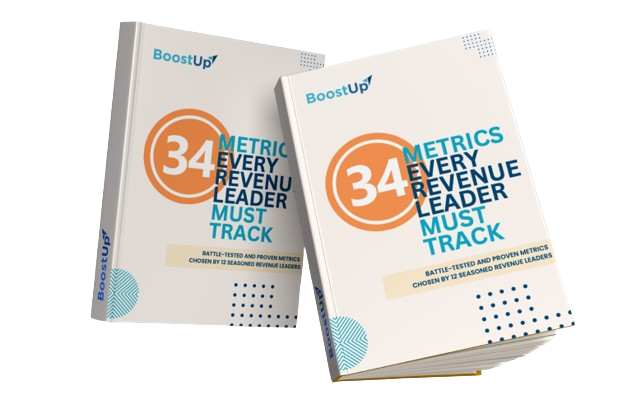Neel Kamal:
And so somebody in your role, Imran, is the expert or has the mastermind to think about the state of the business and metrics that matter. What we are going to do today is record this session for your experience of metrics that matter, that you have been dealing with. And the purpose is for other young revenue operations leaders across the world who want to learn and want to go through this experience to benefit from your journey and your learnings.
Neel Kamal:
I thank you again for doing this, Imran and the floor is yours.
Imran Musaev:
Sure. Sounds good. Well, first of all, I'll say that as I was thinking about the topic of this session, it sort of made sense to focus on what's burning, what's top of mind at the moment, at least for us. And so the topic of Pipe Generation came up pretty naturally and it's pretty fascinating how data oriented this industry is becoming.
Imran Musaev:
I think in my time, in sales ops, RevOps, the volume of data has significantly increased. And like you said, I think we're all grappling with trying to understand, you know, which exactly metrics, out of all the things that we could be doing, we should be doing. So in that sense, from pipe generation perspective, my preference is to keep things simple.
Imran Musaev:
So the four metrics that I outlined here are primarily around activity metrics, the actual pipe generation, conversion rates and the actual bookings - influenced and sourced. So none of this is rocket science on you, but I think there are some interesting nuances and learnings which we figured over time, which I'm happy to dive into.
Neel Kamal:
Super. Let's look at them.
Imran Musaev:
All right. So from activity perspective, I think the first key point here is that it's super important to track activities. We actually were not doing that in the beginning, and then it took us some time to figure out the value of being data oriented in understanding how our reps, and BDR, SDR’s are spending their day right. So does the fact and the need of tracking calls, emails, LinkedIn messages.
Imran Musaev:
There are many other data sources these days which I think has a ton of value to track like, for example, content shares, you know, conversational intelligence recordings, all of those things. As many of those sources as you can use, I would encourage to use all of them and consolidate. It's very important to look at it by type, by region, by person - not just SDRs and BDR’s, are expected to prospect.
Imran Musaev:
So we look through the same lens at our Account Executives, even though we apply different benchmarks to them.
Neel Kamal:
That is superbly put, Imran. You said that, you know, you were not looking at it before, was it the technological challenge of capturing this? Or the value of this metric that were a question mark in your mind?
Imran Musaev:
I think it was more a question of within all the metrics that we could be tracking, what should we tackle first? What should we tackle next? And it's actually very natural. And in particular in sales ops roles, very much focused on the pipeline itself, but ignoring how do you actually get to that pipeline? And then at the times when more pipeline is important, you start thinking about where does it come from, what are the leading indicators that you can track?
Imran Musaev:
And this is where you start thinking, okay, so I need to actually understand what's happening, what’s getting us to a meeting, who's doing it better? There are certainly reps who are, you know, having better conversion from their activities to meetings. What are they doing differently than the other people? So, you know, asking all these questions, made us understand that this is actually an important metric that we need to track.
Imran Musaev:
And this is where honestly I aim for consistency. It's not necessarily the highest volume of activity which wins, right? As you look at the distribution by Rep, there would be people at the top. Some of them have the level of activity so high that I would even wonder how much research goes into that kind of messaging, right? So that's actually something that we can use as a coaching moment, even in case of extremely high activity as well as the level of like low level of activity on the other end of the spectrum.
Neel Kamal:
Got it. So you're not necessarily just looking for winners or stack ranking them, you're looking for everybody need to be at least at a certain level. And that's your target activity. That makes sense. How do you factor in false positive? An example of false positive would be somebody who sent out a lot of emails, but got “out of office reply” or somebody who had several exchanges just to figure out a time of a meeting.
Neel Kamal:
There was no selling involved. It was just trying to schedule a meeting. How do these factors affect your thinking on this chart?
Imran Musaev:
Yeah, great question. I think a lot of it goes into how your tracking system is set up, what kind of activities you end up recording as activities versus not, and what do you filter out. So it's very important to set those filters correctly so that you only treat the right activity as the activity.
Neel Kamal:
Got it! And automating it using the right technology, I would imagine, is also a close next step because manually doing all of this is very hard and truth gets hidden in that.
Imran Musaev:
Exactly. Yeah. And while I'm actually talking here primarily about the activities which are leading to a meeting, but obviously there's a whole topic of activities related to existing pipeline, activities related to existing opportunities. And actually we've done some analysis in terms of the level of activity was on opportunities which we do close, versus those which end up being lost.
Imran Musaev:
And there is actually a very strong pattern in terms of the volume of activity per week where the winning opportunities, the winning deals have to the tune of 2 to 3 times more activities than the losing ones. So you can also use this as a predictor of where the opportunity is going.
Neel Kamal:
That's superbly put. Um, I think even at Boostup, that is a strong correlation that we see in our forecasting measure, that activity is a strong indicator of success and lack of activity or disengagement is also a very strong predictor of loss, and at least majority curve of your opportunities will fall in and obviously there will be outliers, but that's superb !
Neel Kamal:
So activity is your primary metric. You are trying to get to everybody at a certain stage and not necessarily looking for just maximas or minimas. Okay, let's go to the next one.
Imran Musaev:
Yeah so, Actual Pipe Generated - this is an interesting one because there is occasionally a tendency to kind of talk about large numbers. Hey, this is the number that the dollar amount of pipeline that was generated in that particular month, particular quarter. And those numbers tend to be very high. But I think what's most important is the actual volume of deals coming in, the meetings and SQL’s.
Imran Musaev:
So however you track the pipeline, because with the dollar amounts - one, honestly it’s a metric which is easy to manipulate, like there's no scalable way to validate what’s the actual size of an opportunity so early on in the deal. And honestly, the rep wouldn't even know in particular if you're selling multiple products, if you have a product footprint which is wide and you would not necessarily know which of these products will ultimately be part of the deal.
Imran Musaev:
So your deal value may be very skewed. So in that sense, I actually prefer to look at the volume of meetings than the dollar amounts. The other important angle for me here is that we obviously look at it by rep and by BDR, SDR in terms of how many meetings and pipeline opportunities they created.
Imran Musaev:
But it's also important to look at them as a team. So in our case, for example, we have a structure where an account executive and a BDR are working as a team. And while it's important to look at them individually, but it's also important to look at them as a team because we also encourage them very much to be collaborative when building their prospecting strategies.
Imran Musaev:
And there could be some reps, some situations, some scenarios where they AE may be more focused on building some strategic relationships, and the BDR would be actually executing some of the prospecting activity. So while on paper, the actual meeting may be sourced by BDR, it was actually a collaboration between the two. So I think the timing aspect is how we look at the pipeline created is extremely important.
Neel Kamal:
So that's superbly interesting. so the most leading indicator for you is meeting, and then it leads to SQL’s and that leads to pipe generated, which is in dollar amount or number of opportunity, whichever way you want to plot it. Are you able to dedupe it to unique meetings or you are saying that cumulative meetings is what matters?
Neel Kamal:
There could be one opportunity which itself had seven meetings in that quarter.
Imran Musaev:
Yes. So by the meeting, for this particular metric, we are referring to the first meeting with a particular account and we want to make sure that we track it as an explicit metric. It's certainly important after that meeting happens. We do a lot of work looking at what actually happens with that meeting. Does it proceed forward, does it get disqualified?
Imran Musaev:
We're very focused on putting some nurture campaigns to those first meetings which do get disqualified, but then tracking of any subsequent meetings becomes a separate metric. But it's not necessarily part of this initial KPI.
Neel Kamal:
Have you been able to identify a target correlation? How many meetings leads to either a dollar amount of pipeline generated or SQL’s?
Imran Musaev:
Yeah, we do that pretty much all the time, it does vary by rep, by region. And honestly, again, we are not starting really looking at the dollar amounts until the opportunity progresses to a later stage. So really it's about conversion of those meetings into the deals and then deals progressing, progressing through the stages and we only look at the dollar amounts later on in the cycle.
Neel Kamal:
Got it. So you're not necessarily looking at this to inform your pipe gen investment decision, but more to diagnose in this chart, on what is happening with Tanya that despite very high number of meeting, why is the pipeline low? Is that the idea of this chart?
Imran Musaev:
Yes, now certainly in the back end, we're also looking especially as we're doing budget planning next quarter, planning next year planning, right, in terms of what's working, what's not, and where we should put additional investments, but in the first place for me, this is very much about diagnosing what's happening in a particular region, in a particular pairing of AE’s and BDR’s and AE, BDR performance.
Neel Kamal:
Superb! Currently are your tools set at a level where you are able to do this, even if there is one BDR for two AE’s, you're able to separate it out?
Imran Musaev:
Yes. Yes. So we have territories set up in the way, and the AE-BDR pairing set up in a way where we basically look at AE’s territory as the chunk of, you know, accounts, which means coverage. And so we're able by looking at who is the owner of the account and that would typically be an AE, we would determine in which sort of pair of AE-BDR should a particular meeting or a SQL for.
Neel Kamal:
That’s very good. Thank you for sharing Imran, let's go to the next one.
Imran Musaev:
All right. So conversions, obviously super important metric. We have the sales process which is defined in several stages, all of which have specific gates and expected actions which need to be taken and we're very focused in understanding what's actually happening as the deal is progressing from one stage to the other. So in this example, basically looking at you know, the sort of waterfall of how many deals entered the system, how many of those went to the next stage and then progressed to ultimately the closed won.
Imran Musaev:
This one is interesting because there is a tendency to try to increase what you want to do, obviously make improvements at each step, which is important, but I notice that an increase in conversion may or may not be actually a positive indicator because an increase in conversion may also indicate that your gates are not working. Like, for example, if you're passing everything from your qualification stage to the next stage on paper, it may look good, but it may also mean that your qualification process is not working and you'll see a large dropoff later on.
Imran Musaev:
So that's just something that we're continuously looking at.
Neel Kamal:
I see. Are you doing the stage conversion by time freezing within a particular quarter? Because as you're going down, more time needs to spend. What is the right formula that works for you?
Imran Musaev:
So for overall analysis like this, the kind of the starting point would be would take all the deals which closed in a particular period, whether they were closed won or lost, and would look how this kind of funnel looks for them. Without putting any constraints on when the deal actually was started, so we can cover all of the period, but then we do something more granular for a particular quarter when we look more of, you know, coverage of pipeline as we enter the quarter and how much of that ends up being won.
Imran Musaev:
So that's more for, you know, tactical predictability within a particular quarter.
Neel Kamal:
Let me understand, in some ways these charts are two different kinds. First is start from the bottom of closed won and lost and go up without a time filter. That obviously allows you to look at all data in a holistic picture. The other is, start from current quarter down, which is means all active opportunity at different stages on first day of the quarter and you're trying to see stage progression within the quarter, but you might not get to stage 6 or win for a lot of deals.
Neel Kamal:
So what analysis would you get out of the second type of chart?
Imran Musaev:
Well, we would look at it, first of all, by segment of accounts, there are different trends which we're seeing, whether it's, you know, a smaller commercial account or a larger enterprise. Obviously, larger enterprises do not progress as much, so we can look at what reps are forecasting in a particular quarter and knowing how we expect the conversion to work on an enterprise accounts in the next three months, we can sometimes challenge reps assumptions in their forecast where they may have, you know, 10 enterprise deals in stage one or two and they would be forecasting five of them.
Imran Musaev:
But we know that that's unlikely to happen just because of the time frame right? So more granular understanding by the account type, by region, and by rep allows us to add an additional sort of accuracy factor to our forecasts in a particular quarter.
Neel Kamal:
I see. So the second analysis will help you understand your forecast better. And this analysis, which is from closed won upward, what does that analysis help you do?
Imran Musaev:
this is more to diagnose what's actually happening at each stage of the funnel and where overall if we move away from the time constraints, right. What are the biggest the drop-offs? Like are the demos not working or are we not pitching the correct way or you know, again, back to qualification discovery questions like more from a methodology perspective, what's working, what's not and what needs to be tweaked.
Neel Kamal:
Got it. So therefore you have in mind a healthy conversion rate, both more than that is unhealthy and less than that is unhealthy. If it is less than that, that means something is not working. If it is more than that, then your gating system is not working. Very, very good. I think you're looking at both sides of the equation which is superb.
Neel Kamal:
This will be very helpful for customers who are trying to learn the way stage conversion analysis can help them. Okay. Let's go to our next one, which is ARR booking influenced.
Imran Musaev:
Yeah. So this is something we are starting to put more and more focus on because especially in my role in the Rev Ops role, I spend a lot of time thinking about alignment between the different parts of the go to market organization, in particular sales and marketing. And the traditional way that we've been doing things in terms of the success created is for both teams.
Imran Musaev:
By the traditional way, for the marketing, success criteria has always been, okay, more pipeline, more pipeline. We just talked about how, you know, the pipeline metric itself, it's an important leading indicator, but it's easy to misinterpret, easy to manipulate. So ultimately, what we are starting to add into the mix is how much of the pipeline which actually closes has been touched or influenced by different stakeholders in the go to market team, whether it's marketing or perhaps customer success or somebody else.
Imran Musaev:
The downside, of course, is it's more of a lagging indicator, but it's really important because it's more of a hard number, which really tells you out of all the business that you end up closing, you know, what investments ended up working and what tactics, what campaigns ended up working. So then you can tune your top of the funnel, middle of the funnel activity in line with that.
Neel Kamal:
Makes sense. This is actually very powerful. If you see ARR influenced through marketing as very low, what action does that construed to in your mind?
Imran Musaev:
Well I think we want to go back and see what are the touchpoints during the cycle and before the deal cycle that our marketing team is having. I mean, first of all, you want to of course, make sure that your data is accurate, right? This one from the definition and data perspective is a little tricky, but as long as you make sure that the data is accurate, then you want to go back to your campaigns and your marketing team, understand what are those touchpoints, and perhaps you know, think through additional nurture campaigns, go back to the stages again, see what is the contribution of the different go to market players at each stage.
Imran Musaev:
Right? So that it's not just the account executive who is the lone wolf in the field after the opportunity gets created. The whole idea here is to incentivize the collaboration across go to market so that nobody's work is done until a deal actually closes.
Neel Kamal:
Very well! Is also another very powerful, influential metric. I recently read a blog article about ARR being influenced as a very important metric to cover across your overall ARR production. So superbly put, Imran. I want to thank you. Congratulations you are a Revenue Maverick. Once this video is public, there might be people who will reach out to you.
Neel Kamal:
They might look for your advice, your direction. And as a Revenue Maverick, the more you can help the community and the future revenue operations leader, the better it will be. And so, again, thank you so much.
Imran Musaev:
Sounds good. It was a pleasure.
Neel Kamal:
And for the audience, metrics like these powers the business. Please check out BoostUp RevBi - this is a platform where you can not only build and plot metrics like these but actually double click, triple click and analyze them and understand your business. Doing root cause analysis on your business is needed more than ever, and now is the time to put this in your ecosystem. Check us out. Enjoy. Bye Bye now.








